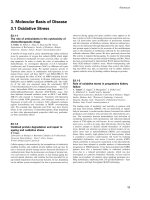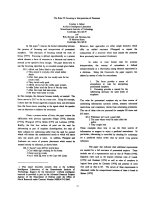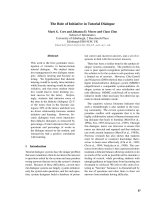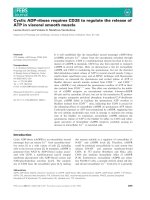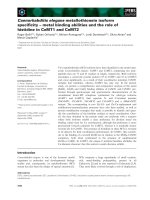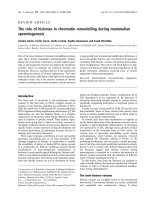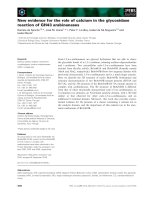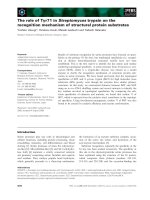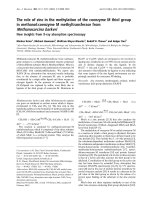THE ROLE OF SWI/SNF IN REGULATING SMOOTH MUSCLE DIFFERENTIATION
Bạn đang xem bản rút gọn của tài liệu. Xem và tải ngay bản đầy đủ của tài liệu tại đây (4.17 MB, 114 trang )
!
CHEMOMETRICS APPLIED TO THE DISCRIMINATION OF SYNTHETIC
FIBERS BY MICROSPECTROPHOTOMETRY
A Thesis
Submitted to the Faculty
of
Purdue University
by
Eric Jonathan Reichard
In Partial Fulfillment of the
Requirements for the Degree
of
Master of Science
May 2013
Purdue University
Indianapolis, Indiana
!
ii
For the love of my life, Tina
!
iii
ACKNOWLEDGMENTS
I would first like to acknowledge and thank my advisor and mentor, Dr.
John V. Goodpaster for giving me the opportunity to accomplish my academic
goals. I would also like to thank Dr. Stephen L. Morgan from the University of
South Carolina for introducing me to forensics and being a collaborator with my
research while here at IUPUI. I would like to give special thanks to Dana Bors,
Wil Kranz, and Maria Diez for acquiring spectra for the external validation. My
research was supported by Award No. 2010-DN-BX-K220 awarded by the
National Institute of Justice, Office of Justice Programs, U.S. Department of
Justice. The opinions, findings, and conclusions or recommendations expressed
in this publication are those of the author(s) and do not necessarily reflect those
of the Department of Justice. Finally, I would like to thank all my family, friends,
professors, and the members of the Goodpaster group for all the advice and
assistance during my studies.
!
iv
TABLE OF CONTENTS
Page
LIST OF TABLES vi
LIST OF FIGURES vii
LIST OF ABBREVIATIONS ix
ABSTRACT xi
CHAPTER 1. INTRODUCTION TO FIBERS AND CHEMOMETRICS 1
1.1. Textile Fibers 1
1.1.1. Natural and Manufactured Textile Fibers 1
1.1.2. Fiber Dyes 3
1.1.3. Forensic Fiber Analysis 4
1.2. Chemometrics 6
1.2.1. Application of Chemometrics to Forensic Science 6
1.2.2. Preprocessing Techniques 8
1.2.3. Agglomerative Hierarchical Clustering 10
1.2.4. Principal Component Analysis 12
1.2.5. Discriminant Analysis 15
CHAPTER 2. CHEMOMETRIC ANALYSIS OF BLUE ACRYLIC VISIBILE
SPECTRA 17
2.1. Introduction and Purpose 17
2.2. Materials and Methods 18
2.2.1. Materials 18
2.2.2. Instrumental Analysis 20
2.2.3. Data Analysis 20
2.3. Results and Discussion 21
2.3.1. Training Set 21
2.3.2. External Validation 32
2.4. Conclusions 35
CHAPTER 3. MICROSPECTROPHOTOMETRIC ANALYSIS OF YELLOW
POLYESTER FIBER DYE LOADINGS WITH UTILIZATION OF
CHEMOMETRIC TECHNIQUES 37
3.1. Introduction and Purpose 37
!
v
Page
3.2. Materials and Methods 37
3.2.1. Materials 37
3.2.2. Instrumental Analysis 39
3.2.3. Data Analysis 39
3.3. Results and Discussion 41
3.3.1. Calibration Plots 43
3.3.2. Training Set 44
3.3.3. External Validation 54
3.3.4. Pair-Wise Comparisons 56
3.4. Conclusions 57
CHAPTER 4. LIMITATIONS AND FUTURE WORK 58
4.1. Limitations 58
4.2. Future Work 59
LIST OF REFERENCES 61
APPENDIX. ADDITIONAL FIBER FIGURES 69
A.1. Blue Acrylic Fibers 69
A.1.1. Training Set Exemplar Spectra 69
A.1.2. External Validation Exemplar Spectra 75
A.2. Yellow Polyester Fibers 81
A.2.1. Calibration Plots 81
A.2.2. Training Set Exemplar Spectra 84
A.2.3. External Validation Exemplar Spectra 89
A.2.4. PCA Projections of Pair-Wise Comparison Data 94
!
vi
LIST OF TABLES
Table Page
Table 2.1. Images of the representative exemplars 18
Table 2.2. Naming system used for eleven exemplars along with their dye
compositions 19
Table 2.3. Cross-validation confusion matrix of the training set 31
Table 2.4. Confusion matrix of the prediction set 33
Table 3.1. Exemplars A-E with respective dye loadings in weight percent and
images 38
Table 3.2. Exemplars F-J with respective dye loadings in weight percent and
images 38
Table 3.3. Calibration curve results for three unknowns using a statistical and
non-statistical approach 43
Table 3.4. Cross-validation confusion matrix of the training set 52
Table 3.5. Cross-validation confusion matrix of classes generated from
dendrogram 54
Table 3.6. External validation results 55
Table 3.7. Pair-wise comparison results 56
!
!
vii
LIST OF FIGURES
Figure Page
Figure 2.1. Representative spectra of the eleven blue acrylic fibers 22
Figure 2.2. AHC dendrogram showing the three classes of averaged fibers 23
Figure 2.3. Normalized central objects plot of the three AHC classes 24
Figure 2.4. Projections of the data in the first and second principal
component 25
Figure 2.5. Projections of the data in the first and third principal
component 26
Figure 2.6. Projections of the data in the second and third principal
component 26
Figure 2.7. Factor loadings plot of the first two principal components 27
Figure 2.8. Regions of high correlation (factor loadings) superimposed over
the fiber spectra 28
Figure 2.9. Projections of the data in the first two canonical variates 29
Figure 2.10. Projections of the data in the first and third canonical variate 29
Figure 2.11. Projections of the data in the second and third canonical
variate 30
Figure 2.12. Projections of the data in the first two canonical variates of the
prediction set 34
Figure 2.13. Projections of the data in the first and third canonical variate of the
prediction set 34
Figure 2.14. Projections of the data in the second and third canonical variate of
the prediction set 35
Figure 3.1. Fiber spectra with adjusted absorbance values for A) background
subtracted and normalized data and B) background subtracted
only data 42
Figure 3.2. Magnified view of the shift of the absorbance maximum as dye
loading increases 45
Figure 3.3. AHC dendrogram of the ten exemplars from the training set 46
!
viii
Figure Page
Figure 3.4. AHC central objects plot of the three classes 47
Figure 3.5. Projections of the data in the first two principal components 48
Figure 3.6. Projections of the data in the first two principal components
of the class data 48
Figure 3.7. Factor loadings plot of the first two principal components 49
Figure 3.8. Regions of high correlation (factor loadings) superimposed
over the three classes of fiber spectra from AHC 50
Figure 3.9. Projections of the data in the first two canonical variates 51
Figure 3.10. Projections of the data in the first two canonical variates
of the classes generated from the dendrogram 53
!
ix
LIST OF ABBREVIATIONS
(w/w) weight percent
X magnification
AA acrylamide
AHC agglomerative hierarchical clustering
ATR attenuated total reflectance
AUC area under the curve
CE capillary electrophoresis
CI colour index
cm
-1
wavenumber
CV canonical variate
DA discriminant analysis
DHC divisive hierarchical clustering
FTIR Fourier transform infrared spectroscopy
IR-MALDESI infrared matrix-assisted laser desorption electrospray
ionization
LC-MS liquid chromatography-mass spectrometry
LDA linear discriminant analysis
MA methyl acrylate
MMA methyl methacrylate
MSP microspectrophotometry
NAS National Academy of Sciences
nm nanometer
PAN polyacrylonitrile
PBT polybutylene terephthalate
PC principal component
!
x
PCA principal component analysis
PCR principal component regression
PEN polyethylene naphthalate
PET polyethylene terephthalate
PLM polarized light microscopy
PPT polytrimethylene terephthalate
QDA quadratic discriminant analysis
ROC receiver operating characteristic
SIMCA soft independent modeling of class analogy
Std. Dev. standard deviation
SWGMAT Scientific Working Group on Materials Analysis
TLC thin layer chromatography
TOF-SIMS time-of-flight-secondary ion mass spectrometry
VA vinyl acetate
!
xi
ABSTRACT
Reichard, Eric Jonathan. M.S., Purdue University, May 2013. Chemometrics
Applied to the Discrimination of Synthetic Fibers by Microspectrophotometry.
Major Professor: John V. Goodpaster.
Microspectrophotometry is a quick, accurate, and reproducible method to
compare colored fibers for forensic purposes. The use of chemometric
techniques applied to spectroscopic data can provide valuable discriminatory
information especially when looking at a complex dataset. Differentiating a group
of samples by employing chemometric analysis increases the evidential value of
fiber comparisons by decreasing the probability of false association. The aims of
this research were to (1) evaluate the chemometric procedure on a data set
consisting of blue acrylic fibers and (2) accurately discriminate between yellow
polyester fibers with the same dye composition but different dye loadings along
with introducing a multivariate calibration approach to determine the dye
concentration of fibers. In the first study, background subtracted and normalized
visible spectra from eleven blue acrylic exemplars dyed with varying
compositions of dyes were discriminated from one another using agglomerative
hierarchical clustering (AHC), principal component analysis (PCA), and
discriminant analysis (DA). AHC and PCA results agreed showing similar
spectra clustering close to one another. DA analysis indicated a total
classification accuracy of approximately 93% with only two of the eleven
exemplars confused with one another. This was expected because two
exemplars consisted of the same dye compositions. An external validation of the
data set was performed and showed consistent results, which validated the
!
xii
model produced from the training set. In the second study, background
subtracted and normalized visible spectra from ten yellow polyester exemplars
dyed with different concentrations of the same dye ranging from 0.1-3.5% (w/w),
were analyzed by the same techniques. Three classes of fibers with a
classification accuracy of approximately 96% were found representing low,
medium, and high dye loadings. Exemplars with similar dye loadings were able
to be readily discriminated in some cases based on a classification accuracy of
90% or higher and a receiver operating characteristic area under the curve score
of 0.9 or greater. Calibration curves based upon a proximity matrix of dye
loadings between 0.1-0.75% (w/w) were developed that provided better accuracy
and precision to that of a traditional approach.
!
!
1
CHAPTER 1. INTRODUCTION TO FIBERS AND CHEMOMETRICS
1.1. Textile Fibers
The Locard Exchange Principle states that when two objects come into
contact, there is always a transfer of material.
1
This principle is especially
relevant to trace evidence such as textile fibers. Fibers can be exchanged
between two individuals, between an individual and an object, and between two
objects. This exchange can either occur as a direct transfer or an indirect
transfer. Fiber persistence is another important factor, which will determine
whether or not a fiber will be found after a transfer. There are numerous factors
that will determine the number of fibers lost and the rate of loss. Studies have
shown that the initial rate of fiber loss is rapid. For example, in some studies,18
percent or less of fibers remained after only two hours.
2
It is seen that transfer
and persistence of fibers are two key factors that will determine the significance
of fiber associations.
1.1.1. Natural and Manufactured Textile Fibers
A textile fiber is a unit of matter that has a length that is at least 100 times
its diameter that forms the basic element of fabrics.
3
Fibers can be classified as
either natural or man-made. A natural fiber exists in a largely unaltered state and
can come from a plant, animal, or mineral. Plant fibers can originate from the
seed, stem, or leaf. The most common plant fibers include cotton, jute, flax,
hemp, and sisal.
3
Animal fibers are typically made from animal hairs, therefore,
are made up of proteins. There are three main types of hair produced by
animals: whiskers, guard, and fur. Guard hairs are the most useful when
identifying the species of animal. Some examples of animal fibers include wool,
!
!
2
camel, and rabbit. It is important to note that silk, which is produced by the
silkworm (B. mori), is considered an animal fiber, but it consists of fibroin fiber
proteins instead of keratin fiber proteins like that of fur bearing mammals.
4
The
most common mineral fibers are asbestos. Examples of mineral fibers include
chrysotile, amosite, and crocidolite.
In contrast, a man-made fiber is created from raw materials that are
either natural or chemical based. Manufactured fibers made from natural
materials are classified as cellulosic and manufactured fibers made from
chemical polymers are classified as synthetic. Cellulosic fibers are made from
regenerated or derivative cellulosic polymers like cotton or wood. Examples
include acetate and rayon. Synthetic fibers consist of multiple monomers
covalently linked to one another. Examples of synthetic fibers include polyester,
nylon, and acrylic.
Polyester and acrylic fibers are two of the most widely produced textiles.
Both polyester and acrylic fibers were used in this study and will be discussed
further. Polyester is comprised of any long chain polymer composed of at least
85% by weight of an ester of a substituted aromatic carboxylic acid.
3
Polyester
comes in many forms, but the most successful and popular form is the
polyethylene terephthalate (PET) fiber. It is composed of ester links of aliphatic
(ethylene glycol) and aromatic (terephthalic acid) groups. Other common
polyester fibers include polytrimethylene terephthalate (PPT), polybutylene
terephthalate (PBT), and polyethylene naphthalate (PEN). Acrylic, also referred
to as polyacrylonitrile (PAN), is comprised of any long chain polymer composed
of at least 85% by weight of acrylonitrile units.
3
The other 15% or less is
comprised of methyl acrylate (MA), methyl methacrylate (MMA), acrylamide (AA),
and/or vinyl acetate (VA) to create a copolymer. These monomers are added to
the acrylonitrile backbone in order to improve the dyeability of the fiber.
!
!
3
1.1.2. Fiber Dyes
Dyeing is the process of imparting color to a textile fiber, which can
provide discriminating characteristics for qualitative comparison purposes. Dyes
are molecules that contain chromophores and auxochromes.
5
A chromophore is
a simple unsaturated group attached to benzene or fused benzene rings. There
are two groups of chromophores, one containing π-bonds next to σ-bonds
(double and triple bonds) and another containing non-bonding n-electrons (azo
groups, cyano groups, carbonyl groups). Auxochromes, which increase the
depth of the color and allow the dye molecule to bond to a fiber, are basic salt-
forming groups like hydroxyl groups and amino groups. The dye produces a
color in the visible region of the electromagnetic spectrum due to the
arrangement of the π-electrons and n-electrons in its chromophores.
5
These
locations of high electron density decrease the gap between the ground state
and excited states to allow for energy transitions within the visible region.
Fiber dyes can be classified according to their method of application,
chemical class, or the type of fiber they are applied to. There are nine general
dye classes: acid, basic, azoic, direct, disperse, metallized, reactive, sulfur, and
vat.
6,7
Acid dyes are applied under acidic conditions. Negatively charged
functional groups on the dye molecule form ionic bonds with positively charged
functional groups on the fiber substrate. Typical fiber substrates that are treated
with acid dyes include wool, silk, polyamide, and polyacrylonitrile. Basic dyes are
also applied under acidic conditions. In this case, however, the cationic dye
forms an ionic bond with the anionic fiber functional groups. These dyes are
applied to polyacrylonitrile, polyester, polyamide, and polypropylene. Azoic dyes
are applied to cotton and viscose via coupling between a stabilized diazonium
salt and a coupling component like naphthol.
7
Direct dyes are mostly applied
under slightly alkaline conditions to cellulosic fibers by direct incorporation in the
presence of heat and an electrolyte. Disperse dyes are insoluble in water and
are directly incorporated into polyester, polyacrylonitrile, polyamide,
polypropylene, and acetate/triacetate fibers. High temperatures or the presence
!
!
4
of a carrier is needed to apply the dye, which is held onto the fiber via weak van
der Waals forces and hydrogen bonding.
7
Metallized dyes form metal complexes
through the reaction of a mordant (metal) that is either applied before, after, or at
the same time as the dye.
6
Fibers that are dyed with metallized dyes include
wool and polypropylene. Reactive dyes are applied to cotton, wool, and
polyamide fibers. They react chemically to form covalent bonds with functional
groups on the fiber. Sulfur dyes are applied to cellulosic fibers. The dye is
chemically altered by a reducing agent into a soluble form where it penetrates the
fiber. Once incorporated into the fiber, the soluble dye oxidizes back into its
insoluble form. Vat dyes utilize a similar process to that of sulfur dyes where a
reducing agent is used to form the soluble form and oxidation occurs within the
fiber to form the original insoluble dye.
6
1.1.3. Forensic Fiber Analysis
More often than not a forensic fiber examiner is requested to compare a
known and questioned fiber to determine if the questioned fiber could have come
from the known source. Textile fibers can be compared based on their
macroscopic and microscopic characteristics, optical characteristics, chemical
composition, and color.
1,8-10
There are a variety of techniques that rely on
microscopy, spectroscopy, chromatography, and mass spectrometry that the
examiner can utilize in order to make a comparison.
Techniques used for fiber type comparisons can include
stereomicroscopy, polarized light microscopy (PLM)
11
, Fourier transform-infrared
spectroscopy (FT-IR)
12,13
, Raman spectroscopy
14
, and pyrolysis gas
chromatography coupled with mass spectrometry
15
. Stereomicroscopy is
primarily used to locate and recover fibers of interest. A stereomicroscope can
also be used to identify certain natural fibers like cotton. PLM is primarily used
for synthetic fibers and utilizes polarized light to characterize those fibers based
on their optical characteristics like refractive index, birefringence, and sign of
elongation. FT-IR can determine the chemical composition of a fiber based on
!
!
5
different vibrations of its functional groups when exposed to infrared light.
Raman spectroscopy is considered a complement to FT-IR. This technique uses
inelastic light scattering to characterize functional groups on the fiber. Raman
spectroscopy has the advantage of characterizing not only the fiber polymer, but
also the dye applied to that fiber.
14
Pyrolysis gas chromatography coupled with
mass spectrometry is used in some cases to determine the type of synthetic
fiber, however, this technique can suffer from irreproducible results.
16
Although the comparison of fiber polymers has discriminating power, the
color of the fiber, which is attributed to the dye applied, can be the most
important characteristic when comparing two fibers. Techniques used for fiber
dye and color comparisons can include thin-layer chromatography (TLC)
17,18
, UV-
visible microspectrophotometry (MSP)
5
, liquid chromatography-mass
spectrometry (LC-MS)
19,20
, and capillary electrophoresis (CE)
21
. These
techniques, except for MSP, require some sort of extraction of the dye from the
fiber. An examiner will try to avoid these techniques or utilize them last due to
their destructive nature. TLC, LC-MS, and CE also require correct extraction and
separation solvents and methods in order to identify the dye(s) depending on the
fiber and/or dye in question. This can cause difficulties especially when the
sample is limited in amount. Recent research has been conducted to solve the
problem of extracting thus destroying fiber evidence. Zhou et al.
22
developed a
method for dye identification utilizing time-of-flight-secondary ion mass
spectrometry (TOF-SIMS). This method shows promise, but requires long
sample preparation times and has only been optimized for acid dyes on nylon
fibers.
UV-visible microspectrophotometry is a quick, accurate, reproducible, and
non-destructive technique used by forensic fiber analysts to examine the color of
dyed fibers. Humans are able to perceive color, however, color measurements
between individuals is subjective. Other factors can influence color like lighting
conditions and the phenomenon called metamerism. Metamerism occurs when
two fibers are dyed with different dyes or combinations of dyes, but the perceived
!
!
6
color of the two fibers is the same. Visual differences can be seen between two
metameric pairs of fabric under different lighting conditions, however, metameric
pairs of single fibers cannot be visually discriminated, thus MSP is a vital
technique in the fiber color analysis scheme. A microspectrophotometer is
composed of two parts: a microscope and a spectrometer.
10
The microscope
gathers light from the sample and the spectrometer measures the change in light
intensity as a function of wavelength. MSP can discriminate between two
colored fibers that are visually similar based upon the different chromophores in
the dye’s molecular structure. Research in color comparisons with MSP have
been conducted and show the viability of this technique.
1,23-25
There are
limitations to this technique, however. Resultant spectra tend to be broad and
limited in features, although the first derivatives of the spectra can be taken to
ascertain more information for comparative puporses.
26
First derivatives,
however, can magnify the noise in the spectra, which could lead to harder
interpretation. Quantitative analysis of the dye(s) applied to the fiber is also
limited. For this reason, microspectrophotometric analysis of dyed fibers is used
primarily for comparison purposes. Finally, lightly dyed fibers and darkly dyed
fibers create issues due to the limits of the detector.
1.2. Chemometrics
1.2.1. Application of Chemometrics to Forensic Science
Forensic scientists are familiar with statistics that utilize one variable. An
example of this would be comparing a known and unknown glass fragment
based upon their refractive indices. Until recently, however, the use of
multivariate statistics has been overlooked. Multivariate statistics, also known as
chemometrics when applied to chemical data (e.g., spectra or chromatograms),
is a form of statistics that utilizes multiple variables to describe complex datasets.
Forensic scientists are often tasked with identifying patterns as well as
!
!
7
interpreting any differences between spectra. Currently, this is carried out by
visual inspection and comparison by the examiner. The problem arises when
more than three variables (dimensions) are used as with a collection of
absorbance spectra, which are often contain hundreds or thousands of
wavelengths. Although a trained examiner can locate the presence or absence
of major peaks, subtle differences within the complex data set can be virtually
impossible to find. This especially holds true when there are numerous samples
to be compared.
Chemometrics has the ability to identify patterns and groupings from large
complex datasets more accurately than visual examination alone. It can also
investigate the dependence among variables, make predictions, and be used for
hypothesis testing.
27
Chemometrics does this by extracting information from
large data sets, which in turn allows for easier interpretation. It is important to
note that multiple replicate samples must be acquired to obtain a valid conclusion
from the data set. Since its emergence into the forensic science arena it has
been applied to a number of sample types, including accelerants, document
examination, drug analysis, fibers, inks, glass, gunpowder, paint, soil, and
condom lubricants.
27
Visual comparison of trace evidence can be quite subjective. There is no
statistical basis for the conclusions reached by the examiner. This is a concern
for crime laboratories due to the issues of reliability and relevance of scientific
evidence raised in the case of Daubert v. Merrell Dow Pharmaceuticals.
28
Chemometric analysis of multivariate data often found in trace evidence could
help meet the Daubert requirements.
27
The use of chemometric techniques can
also address two recommendations laid out in the National Academy of Sciences
(NAS) report. Chemometrics could alleviate the issues of accuracy, reliability,
and validity in trace evidence analysis (Recommendation 3) and assist in
research on sources of human error in trace evidence analysis
(Recommendation 5).
29
!
!
8
There are many multivariate techniques that could be applied to
spectroscopic data. The three techniques utilized for this study were
agglomerative hierarchical clustering (AHC), principal component analysis (PCA),
and discriminant analysis (DA). Hierarchical clustering algorithms were created
in the 1950’s. The theory behind PCA was established by Pearson in 1901,
however, the algorithm to compute principal components (PCs) was not
introduced until 1933 by Hotelling due to the lack of machine computing.
27
Discriminant Analysis was first derived by Fisher in 1936.
1.2.2. Preprocessing Techniques
Preprocessing is simply defined as any mathematical manipulation of the
data prior to multivariate statistical analysis.
30
Preprocessing the data before
multivariate statistical analysis is often required to remove or reduce random or
systematic sources of variation in the data set. This allows for easier
interpretation of the data. Improper techniques applied to the data could remove
important variation, so care must be taken when choosing the appropriate
technique. There are two ways the data can be preprocessed before analysis:
sample preprocessing or variable preprocessing. Sample preprocessing
operates on one sample at a time over all variables. Variable preprocessing
operates on one variable at a time over all samples. There are numerous
methods used to preprocess the data, however, only background (baseline)
correction and normalization will be discussed for sample methods and mean
centering will be discussed for variable methods due to their use in the study.
Background correction reduces or eliminates a constant or systematically
varying background within the data.
27,30
There are various ways to background
correct. One method, called the explicit modeling approach, involves subtracting
a fitted model for a trend present in the baseline. Every spectra can be written as
a function of variable number, where the function is equal to the sum of the signal
of interest plus the baseline.
30
When the baseline has an offset baseline feature
(i.e. horizontal line), one number can express the baseline, thus subtraction of
!
!
9
that number from the signal would remove the baseline. When a linearly sloping
baseline is present, two or more points that only contain baseline information can
be used to estimate a line.
30
To remove the sloping baseline, the estimated line
is subtracted from the sample vector. Polynomials of higher magnitudes can be
estimated using this approach depending on the shape of the baseline. Another
method of removing the baseline takes the derivative of the spectra with respect
to variable number. This approach is quite useful because it is not essential to
select points that only contain baseline information.
30
Taking the first derivative
is essentially the same as subtracting out an offset baseline via the explicit model
approach.
30
Taking consecutive derivatives will remove all higher order baseline
shapes. The four most common methods to determine the derivatives are the
running simple difference, the running mean difference, the Gorry algorithm, and
the Savitzky-Golay algorithm. The methods of Gorry and Savitzky-Golay are
preferred because taking the derivative of a sample vector tends to propagate
noise.
27
Normalizing the data usually comes after background correction. It
removes systematic variations associated with sample size, concentration,
amount of sample, and instrument response.
27
This is accomplished by dividing
each variable of the sample by a constant. There are three common approaches
to calculating a constant: normalizing to unit area, normalizing to unit length, and
normalizing to maximum intensity.
27,30
Normalizing to unit area is achieved by
dividing each variable in the sample by the sum of the absolute value of all
variables in that sample. The second approach, normalizing to unit length, is
achieved by dividing each variable by the square root of the sum of squares of all
the variables in each sample. The final approach divides each variable by the
maximum value in the sample so that the maximum intensity is equal to 1.
Mean centering the data processes each variable at a time over all the
samples. In simplest terms, mean centering repositions the centroid of the data
set to the origin of the coordinate system by subtracting out the mean value of
each variable over all the samples.
31
This prevents data points away from the
!
!
10
centroid from having more influence than data points closer to the original origin.
Mean centering is not always appropriate, but for principal component analysis,
mean centering is recommended.
30
1.2.3. Agglomerative Hierarchical Clustering
Hierarchical clustering is a form of cluster analysis and is considered
unsupervised because there is no prior knowledge of the underlying groupings in
the data. It is performed to classify individual samples into groups or clusters
based on their distances from each other. There are two types of hierarchical
clustering techniques that can be employed: divisive hierarchical clustering
(DHC) and agglomerative hierarchical clustering (AHC). DHC starts with all the
samples in a single cluster. The single cluster is split into two smaller clusters
and those clusters are then split until each sample forms its own cluster. This
technique is uncommon because it is computationally demanding.
32
AHC starts
with each sample as its own cluster. Similar samples are clustered together until
a single cluster is formed. This form of hierarchical clustering is more common
and was utilized in this research. A visual representation of the clusters or
groups is presented as a two dimensional plot called a dendrogram. The
dendrogram, often expressed as a hierarchical tree, has the samples on the
vertical axis and the dissimilarity or similarity distance on the horizontal axis.
Branches, visualized as horizontal lines, represent the clusters and nodes.
Vertical lines represent when two clusters are linked together.
33
A truncation line
is often established to determine the significant clusters in the dendrogram. This
line is determined either by the analyst or by more objective criteria.
As stated above, the interpoint distances between samples must be
calculated in order to cluster similar samples together. Distance can be
calculated in terms of similarity or dissimilarity. The most common type of
!
!
11
distance is Euclidean distance, which is based on the Pythagorean Theorem.
It is the geometric distance in multidimensional space and is represented in
Equation 1.1.
33,34
Equation 1.1 is expressed in the matrix format.
d
(x,y)
= [(x – y)’(x – y)]
1/2
Equation 1.1
The distance between points is expressed as d
(x,y)
and (x – y)’ is the transpose of
the matrix (x – y). The smaller the distance between samples the more similar
the samples are to each other. Another common distance measurement is
Manhattan distance. Manhattan distance is slightly different than Euclidean
distance in that the sides of the triangle are summed to determine distance rather
than the length of the hypotenuse. This method diminishes the effects of outliers
and will always be slightly larger than that of the measurement from Euclidean
distance.
32,34
Manhattan distance is presented in Equation 1.2.
33
d(x,y) =
Σ
i
|x
i
– y
i
| Equation 1.2
The correlation coefficient between samples can also be used as a distance
measure. This method computes the cosine of the angle between two samples
to determine their similarity. A correlation coefficient of 1 implies the two
samples are very similar. This method is often used for the comparison of
infrared and mass spectroscopy data.
32
The last distance measurement to be
discussed is Mahalanobis distance. This method is very similar to Euclidean
distance except for it takes into account that some variables may be correlated.
The inverse of the variance-covariance matrix is utilized as a scaling factor,
which can be seen in Equation 1.3.
34
d(x,y) = [(x – y)’C
-1
(x – y)]
1/2
Equation 1.3
The Mahalanobis distance is also employed in discriminant analysis when
predicting the group membership of new samples, which will be discussed in
!
!
12
Section 1.2.5. This method is not always appropriate, especially when the
number of variables exceeds the number of samples because the inverse of the
variance-covariance matrix cannot be calculated.
34
Once the distances between samples are determined, various aggregation
methods are employed to link clusters together. The most common method is
single linkage. This method links clusters based on the distance between the
two closest samples within each cluster. Another method, which is the opposite
of single linkage, is complete linkage. Complete linkage links clusters together
based on the distance between the two furthest samples within each cluster.
30,33
The last aggregation method discussed is Ward’s Method. This method utilizes
an analysis of variance approach by determining the error sum of squares
between any two clusters and linking the two clusters that have the least sum of
squares.
33
Every possible pair of clusters that can be joined must be considered
during each step. The error sum of squares is determined by measuring the total
sum of squared deviations of every sample from the mean of the cluster.
35
Other
aggregation methods can be employed like weighted and unweighted pair-group
average linkage, centroid linkage, or median linkage.
33
Overall, AHC is an appropriate method when trying to determine the
similarity or dissimilarity between samples in a data set. The dendrogram can
provide insight into how the samples cluster as well as outlier detection.
However, AHC cannot determine what variables influence certain clusters. A
technique like principal component analysis (PCA) can be employed to determine
such relationships. Cluster analysis, along with AHC, have been applied to
inks
36
, photocopy and printer toners
37
, glass
38
, soils
39,40
, polymers
41,42
, paint
43
,
fibers
44
, hair dyes
45
, and electrical tapes
46,47
.
1.2.4. Principal Component Analysis
Principal component analysis is the most widely used multivariate
technique. It is also considered an unsupervised technique because it does not
require knowledge of the groupings in the data set. The purpose of PCA is to

